During my time in Nepal, I had the opportunity to finally fulfil my dream of hiking through the Himalayas. As I did not want to take too much time out of my busy schedule that month, I knew the longer and more popular treks like the Annapurna Circuit or Everest Base Camp were not an option for me this time around. So, I decided to do the Langtang Valley Trek, which takes between five to seven days, and takes you through – you guessed it – the different landscapes and altitudes of the Langtang Valley. My friends Laurence and Joshua wanted to join, and we had the best time in the mountains, enjoying the views and exchanging French, Nepali, Dutch and English words and phrases, as well as good stories and memories. So, want to know more about how we got there and the experience we had? Or just want to look at the pictures to fuel your wanderlust? Then continue reading and transport yourself to the Nepalese Himalayan mountains!
How we got to Syabru Besi
Since April, 2023, the Nepali government has forbidden trekking without a guide in the mountains, trying to employ more guides in the country and make trekking safer. Luckily for Laurence and I, our friend Joshua is a trekking guide, making our trip very comfortable and fun. He is a super cool guy, so I would a hundred percent recommend going with him! Furthermore, as I am a true planner, I did not need to plan anything this time, as he knew most of the hotels and the owners in the villages, and thus took care of calling ahead to book rooms and everything that goes with it.
Your guide will also take care of transport to and from Syabru Besi, which can be a private jeep or a bus. We debated for a while whether we wanted a jeep, because I get car sick on mountain roads and especially in buses, but the buses we ended up taking were very spacious and comfortable, and much cheaper. For a tall Dutch girl, the bus actually saved my knees, as the jeeps turned out to be quite cramped.
The bus ride, however, was very long. Because of traffic it took us hours to get out of the Kathmandu Valley, and even more to get closer to Syabru Besi. So, make sure you download audio books, podcasts, and music to keep yourself entertained. Although the view was nice at times, there was so much dust and pollution in the air that we could barely see a thing, so my headphones were a lifesaver.
Although the bus ride was long, we took plenty of breaks to go to the bathroom and get some lunch, both on the way up and down. The bus company also provided us with bottles of water, and the one on the way back even had AC! There are many different bus companies out there, so make sure to ask your guide what you will be in for. Of course, buses with AC will cost you more than the usual public buses, but they also tend to be more comfortable.
In the final stretch of our way up the mountain we had to pull over at a military checkpoint, as the road to Syabru Besi continues to China. Here the air started to get cooler, and the dust started to settle a bit more. When we got out, it even started to rain, which saved our mountain views from being obscured by dust the very next day. While the last part of the ride took us along narrow mountain roads with a solid wall on one side, and steep ravines on the other, we finally arrived in Syabru Besi some ten hours later. I had never been so scared for my life as I was during that final stretch. So, if you are even a little bit afraid of heights: make sure you are asleep, as you do not want to miss out on this trek!
Eventually we turned a corner and descended into the Langtang Valley, where the dust and pollution fortunately did not travel with us. When we checked into our guest house called the Sunrise Hotel, we were exhausted, but excited for the next day. The food at the guest house was wonderful, the rooms were clean and comfortable, and the family who ran the hotel were super kind. Their two daughters kept us company as well and gosh, they were so adorable! That evening had already made the terrifying and excruciatingly long bus ride more than worth it. After some chocolate milk, Joshua gave them our breakfast order, which we had to communicate the night before at every guest house to make sure our breakfast would be on time. We went to bed with exciting dreams about what we would see the following day.
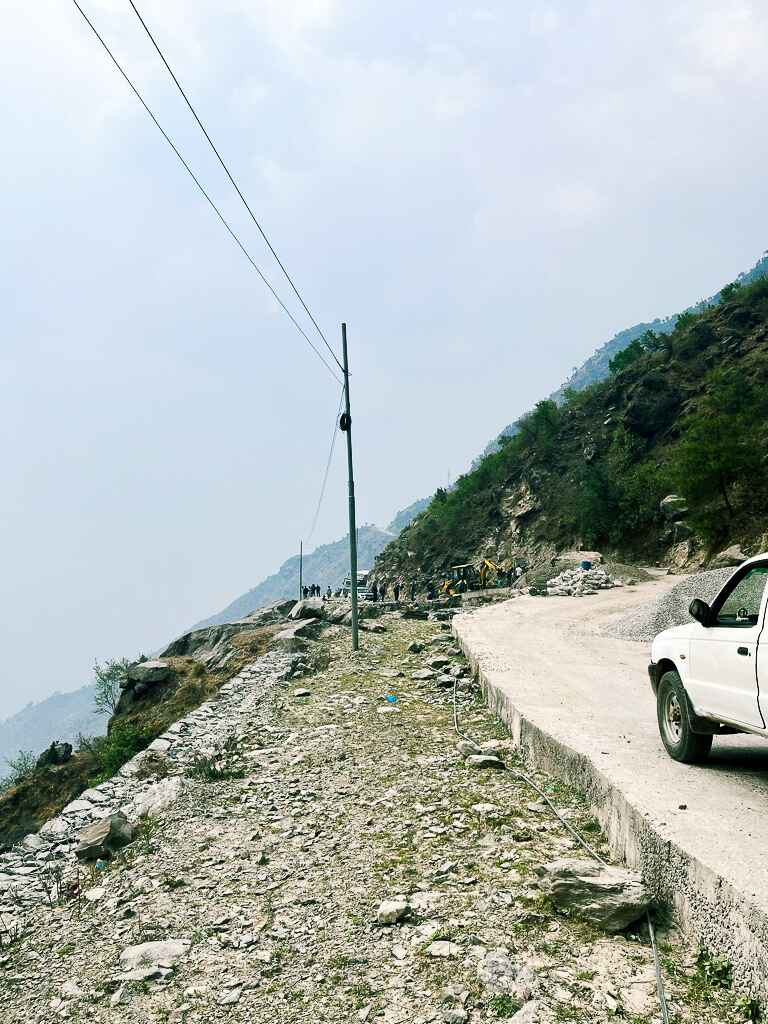
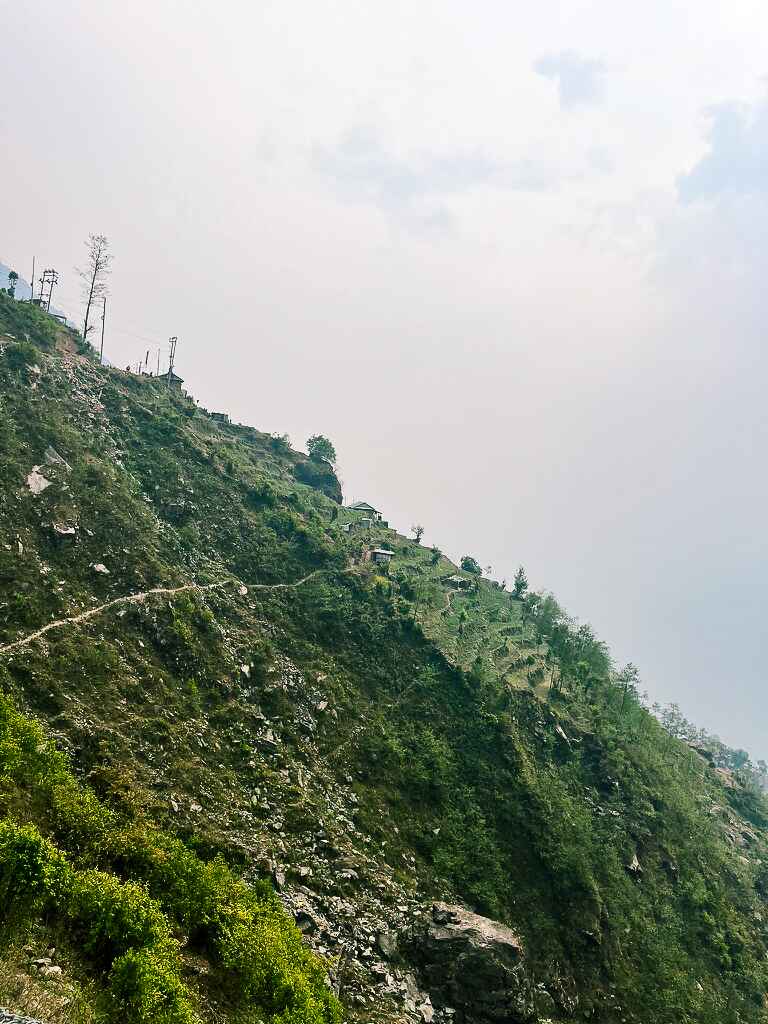
Day 1: Syabru Besi (1492m) to Lama Hotel (2447m)
We started the day bright and early with breakfast at seven, for which our hosts had made some banana buckwheat pancakes and milk coffee. After we left our lovely guest house, we decided to take a detour for the first few kilometers on the left side of the river, as there was a road being built on the right side, and apparently there was some heavy ‘rock-fall.’ The detour also made sure we could enjoy the forest and view of the river without choking on the dust created by passing jeeps. Along this first part we also got our first views of the Langtang range. I told Joshua and Laurence this made me so happy, I would already be content if I had to go back now (luckily I didn’t).
While the first stretch of our day was pretty level, after the end of the road, we started our first climb towards Bamboo, where we would eat some lunch. On our way we crossed various suspended bridges, which shook a little when you crossed them, but mostly felt sturdy enough to carry us across. Although the views were pretty, the amount of stairs we had to climb were not: in the end we had to ascend more than a thousand meters. As I am definitely a lowlander, and I also carried my laptop for my research besides all of my other stuff on my back, this day really confronted me with myself. I was out of breath for most of the time and sweating like crazy, thinking I could not do this for five days. This made me feel defeated for a while, as I thought I would be fit enough.
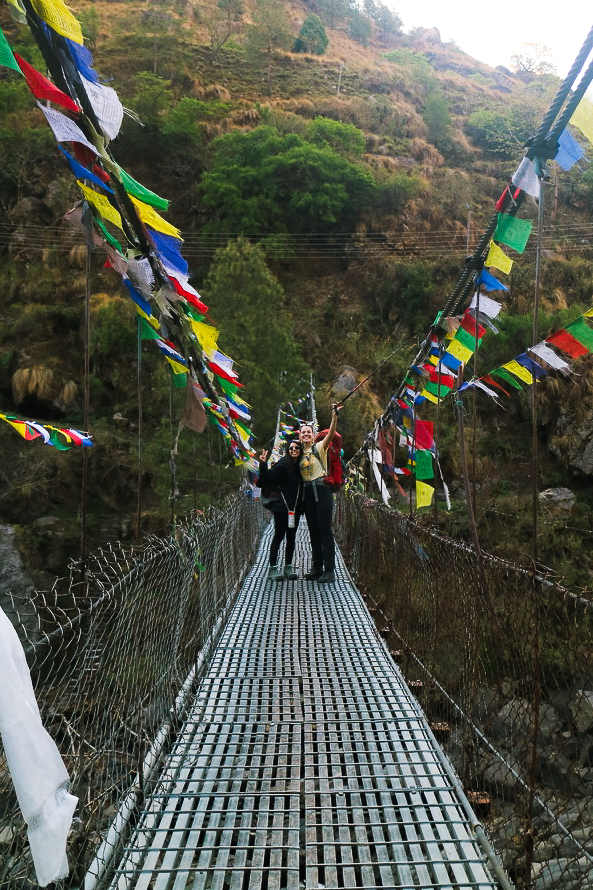

Having walked the entire trek, now I can say this day was especially tough because of the long and continuous ascent. But the views eventually more than made up for it. With sneak peeks of frozen peaks and the lushness of the forest around us, we had a lot of distraction from the stairs. So, by the end of the day we all were tired, but we felt very accomplished. We had finished our first day, and that was reason enough to celebrate.
We arrived in Lama Hotel around three or four PM and went to the hotel our previous guest house had recommended. The room was simple: the beds were made of a flat piece of wood with a thin mattress, and the walls themselves were plain plywood. Although you do get bedding and a pillow, we brought our own sleeping bags, which we ended up needing at higher elevations. What was a true luxury was the hot shower. After such a long “leg-day,” this eased my sore muscles and made me feel so relaxed I could fall asleep any minute. Little did we know that this would be our very last hot shower of the trek.
That night, it was so busy at Lama Hotel, as it is a crossroad of multiple treks and the trekking season had just started up again, that Joshua did not get a room and had to sleep in the kitchen along with the other guides. I was shocked to hear that the porters were not even granted space inside, but had to sleep in tiny tents with too many people inside. This made us decide to skip Lama Hotel on the way back down. Although the food was nice and Laurence and I were able to get a room, the three of us felt like this practice was not very ethical, and preferred to sponsor guest houses that took good care of everyone on the trek.
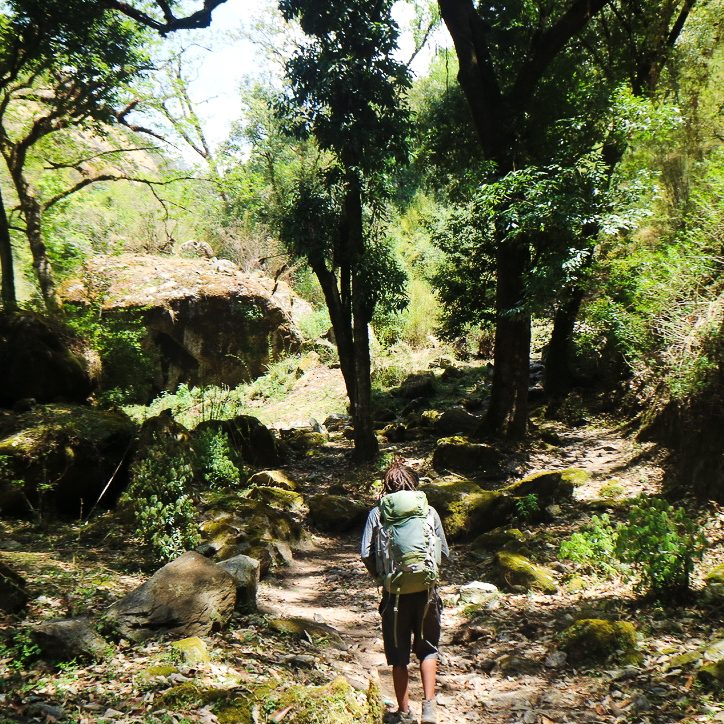
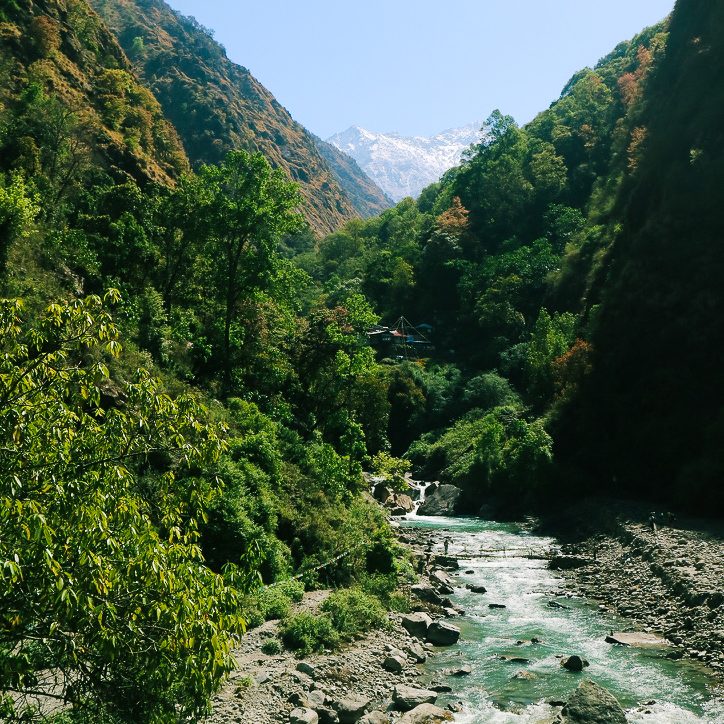
Day 2: Lama Hotel (2447m) to Langtang Village (3500m)
That morning, when we pushed aside our curtains around seven AM, we were surprised with the view of packing-mules grazing outside our windows. That day we would meet many more mules and watch them as they passed us with their heavy burdens. After this surprising wake-up call, we had breakfast and headed out around eight.
From the start, this day already turned out to be very different from the day before. Where the hike to Lama Hotel was mostly through jungle-like forests with bright ferns and green, leafy trees, the trees here were largely covered in moss and got shorter and more ‘bushy’ as the day progressed.
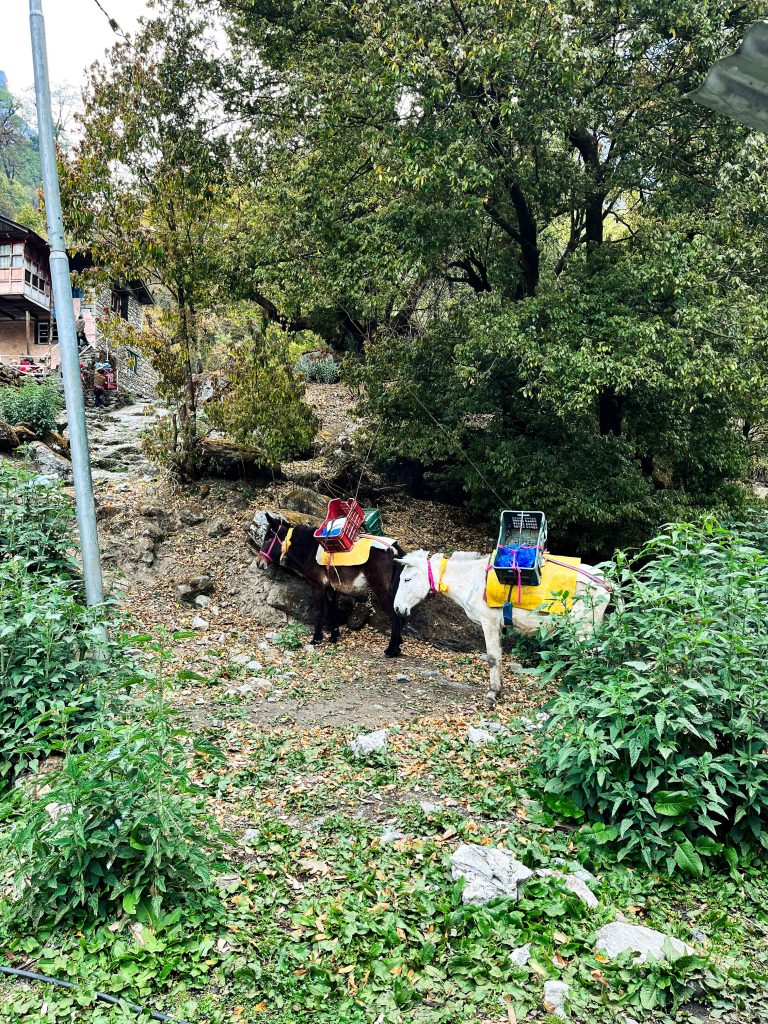

Again, we climbed up, and up, and up, passing large mossy boulders and bright blue creeks. More and more rhododendron trees started to pop up, and Joshua made us try some of their flowers. They were fresh, sweet, and a little bit sour. Mostly, they were delicious, and as I had learned from Narayan Mama back at Conscious Impact, they soothe your throat when it is infected.
After we finished our first big ascent of the day, we ended up in the most magical rhododendron forest I could ever have imagined. There were flowers – white, pink, purple, and red – everywhere. The mossy boulders and serpentine branches of the bushes made it the setting of a fairytale. Eventually, it opened onto a small grassy plain. I think we might have been at 3000 meters by then and it felt like we had been transported to another world. It had been a dream of mine to see these forests in full bloom one day, and it could not have been better than this.
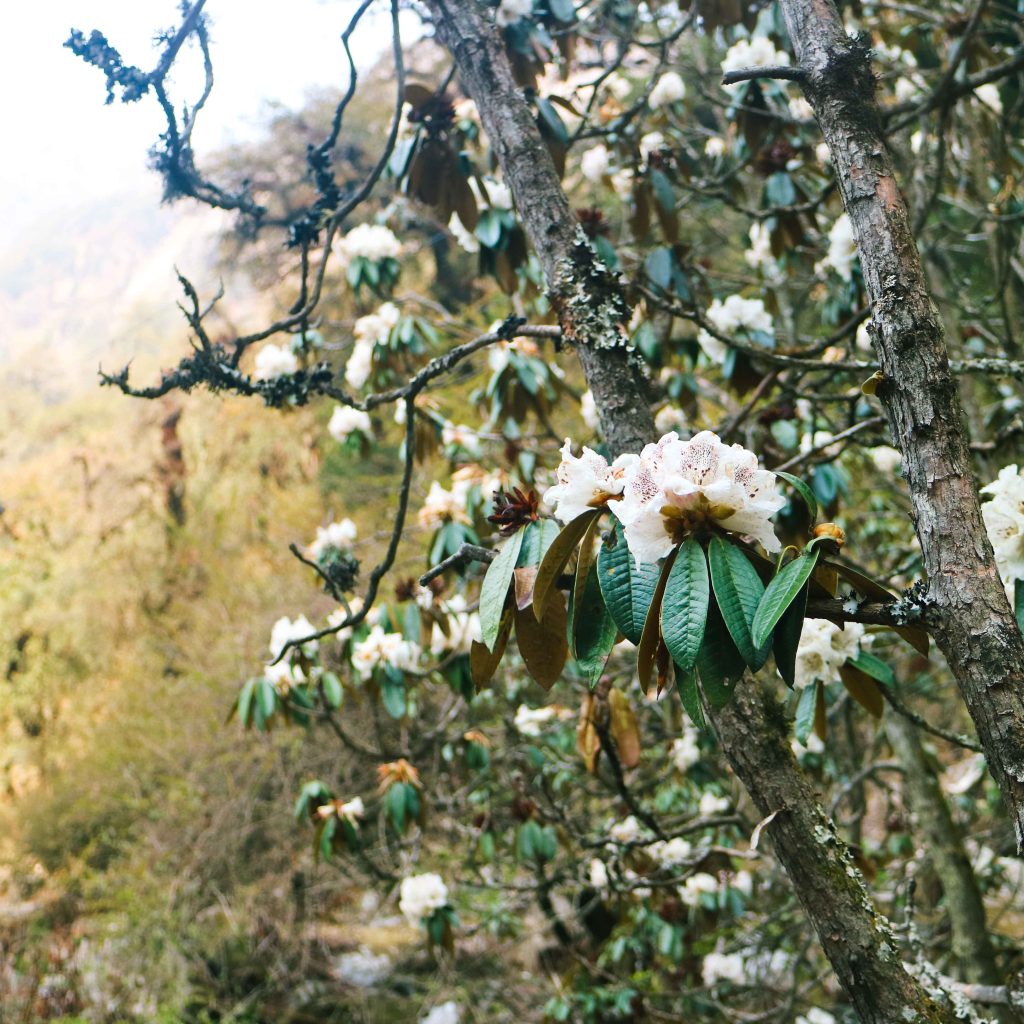
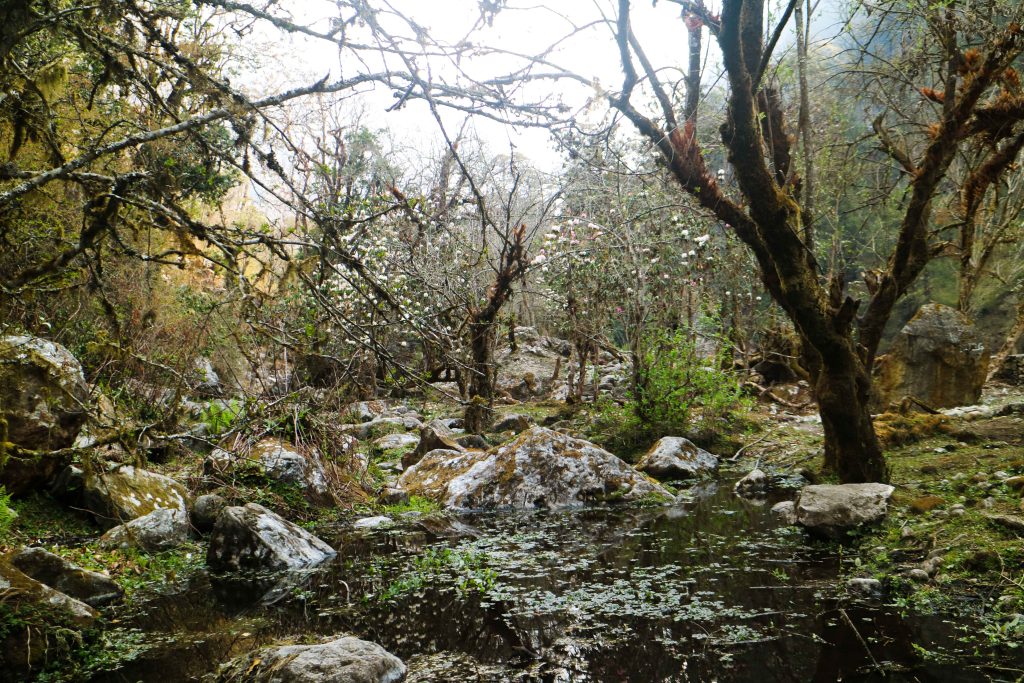
Just after we crossed the treeline a few kilometers later, we found ourselves at a nice guest house with a restaurant where we had lunch. We soaked in the sun and met two guys from South Africa, whom we had some good conversations with. I ordered fried rice again, Joshua had dal baht and Laurence the yummiest potato momo we had ever seen. Unfortunately, it was not gluten-free, but by her happy face I could tell it was absolutely delicious.
During the final stretch I could start to feel the elevation. It was getting harder to walk fast and I had to stop for more breaks because the air was getting thinner. There were no trees to keep us company anymore either and the landscape started to get more arid. There were some bushes here and there, but mostly we could see different kinds of grass, moss, and many yak. I felt like I had landed on another planet. Maybe the moon, but when it had water.
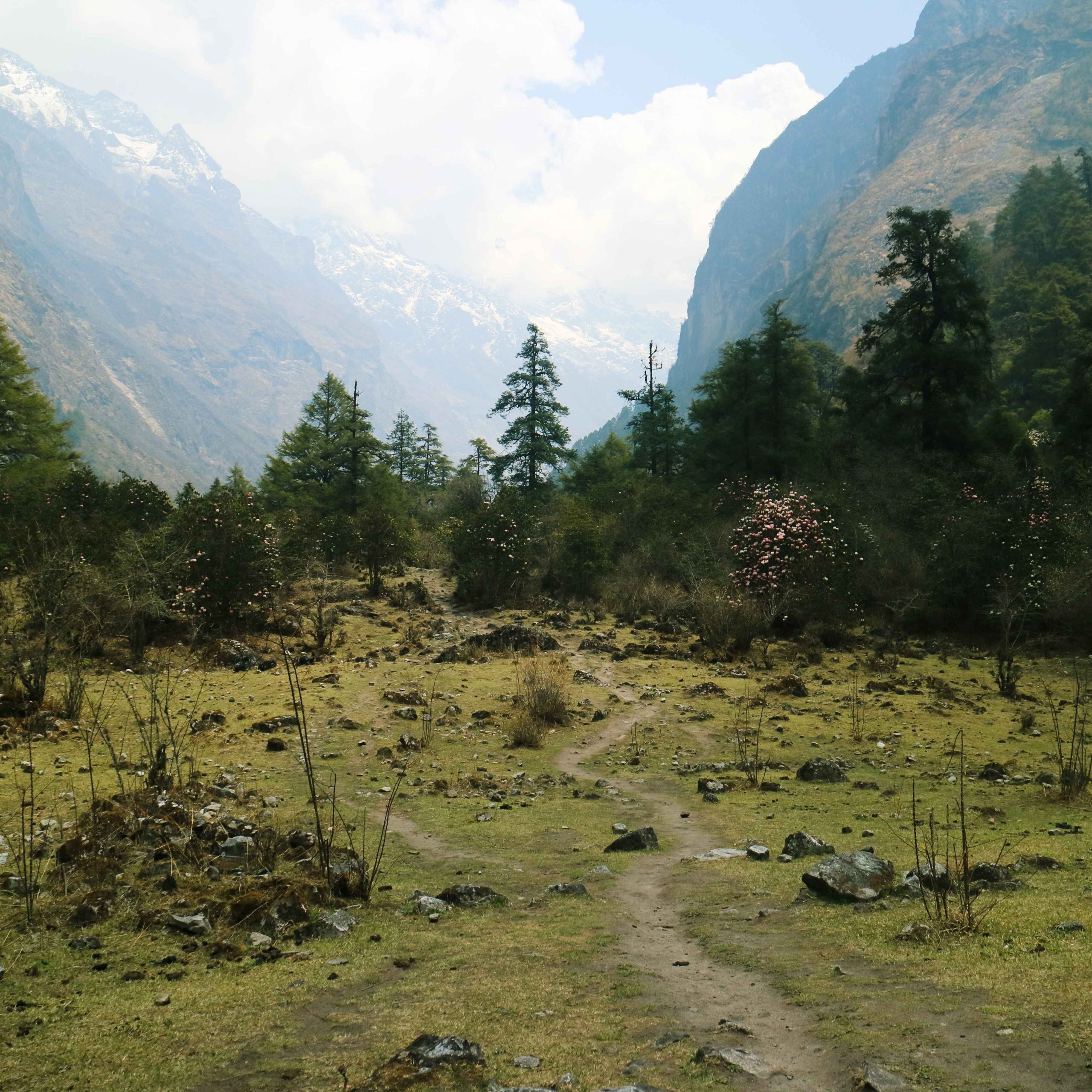
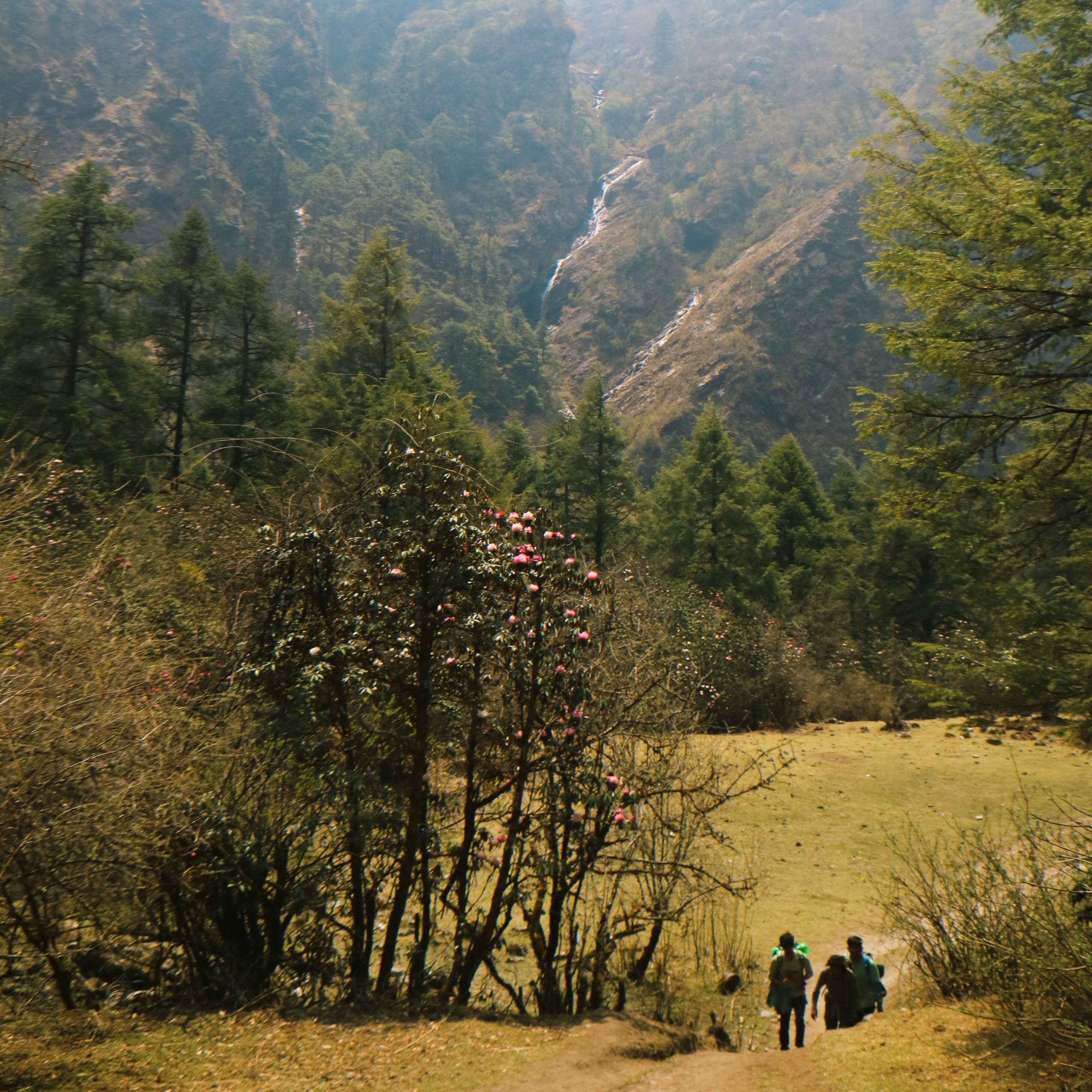
Thirty minutes before we arrived at Langtang Village, we found the remnants of what used to be the village before the earthquake in 2015. Among the rubble you could still see the metal frames of what once were houses and hotels. But mostly, we saw massive rocks lying among them. We could only imagine the devastation and death the natural disaster had cost the community of the Langtang Valley. However, we could not stand around and wonder, as there was still a danger of landslides in that area.
The final climb was over a hill filled with shrines, a temple, and multiple prayer wheels. When we walked into the village, we passed a bakery that advertised with a large picture of a cappuccino. Craving coffee and sweets, we decided to spend the rest of our afternoon there after checking into our new guest house, called the Sunrise Hotel. The cappuccino ended up being amazing, and although they had a wide variety of cakes and croissants, none of them were gluten-free, unfortunately. While Laurence and Joshua made a snowman outside, when the snowstorm finally had arrived, I worked on my interview transcripts while watching them making progress. While they did not have a carrot for the nose, the owner came outside to put an adorable hat on its head.
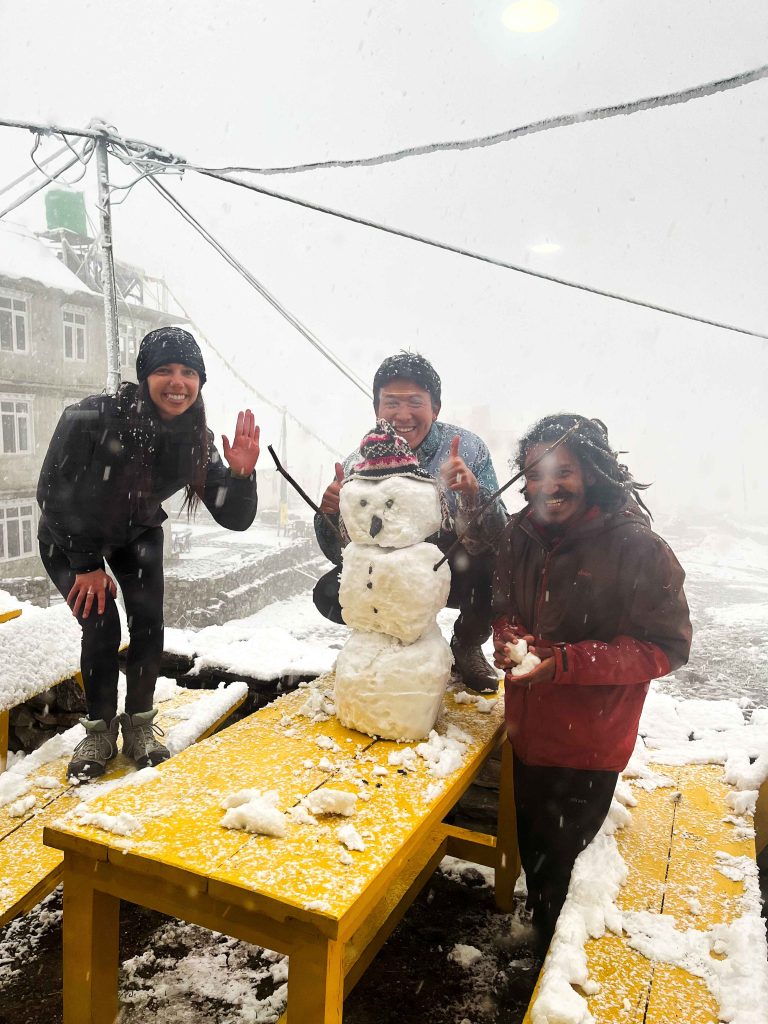
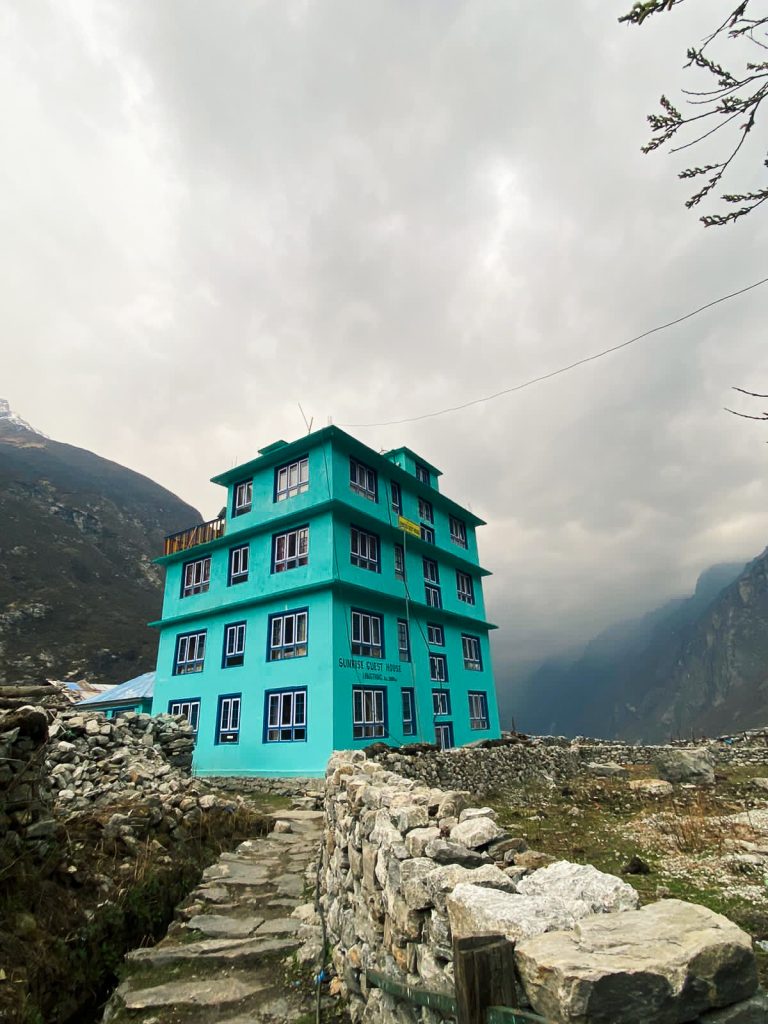
Back at the hotel there was no hot water, so Laurence and I took our first ever bucket shower. This basically means that the hosts will heat up some hot water for you in the kitchen on the stove, poor it in a large bucket, and in your bathroom, you have to pour the water over your body with a smaller bucket. As there is no heating system, this was a chilly endeavor, but refreshing nonetheless!
We had dinner on the top floor where there was a dining room with a heater fueled by yak dung, and we got nice and toasty there. I had dal baht, which was very good this time. Again, we played cards, had some Nepali whiskey with hot water (which was not a good idea, as this worsened the effects the altitude had on me), and relaxed for the next morning, which would take us to our highest sleeping point.
Day 3: Langtang Village (3500m) to Kyanjin Gompa (3830m)
Once again, we had breakfast early, but there was no more fresh milk this high up, so I just had black tea with ginger and honey. This day was by far the hardest day for me. Already when we left the guest house, I was out of breath in the first five minutes. My heart was beating loudly in my chest, and I started to get worried for the next day, when we would reach 4600 meters. It made me a little scared, but as I had no headache, I ended up having nothing to worry about.
The view definitely kept me company, as well as my friends. We chatted a lot, had snow fights and took breaks often. The landscape had truly turned into a winter wonderland, with lots of yak and lots of snow. We also could not see any mountains this day, as the clouds blocked our view. I thought it was funny how just two days ago we were walking in our t-shirts and sweating like crazy, but now we had to keep moving to stay warm in our down-jackets.
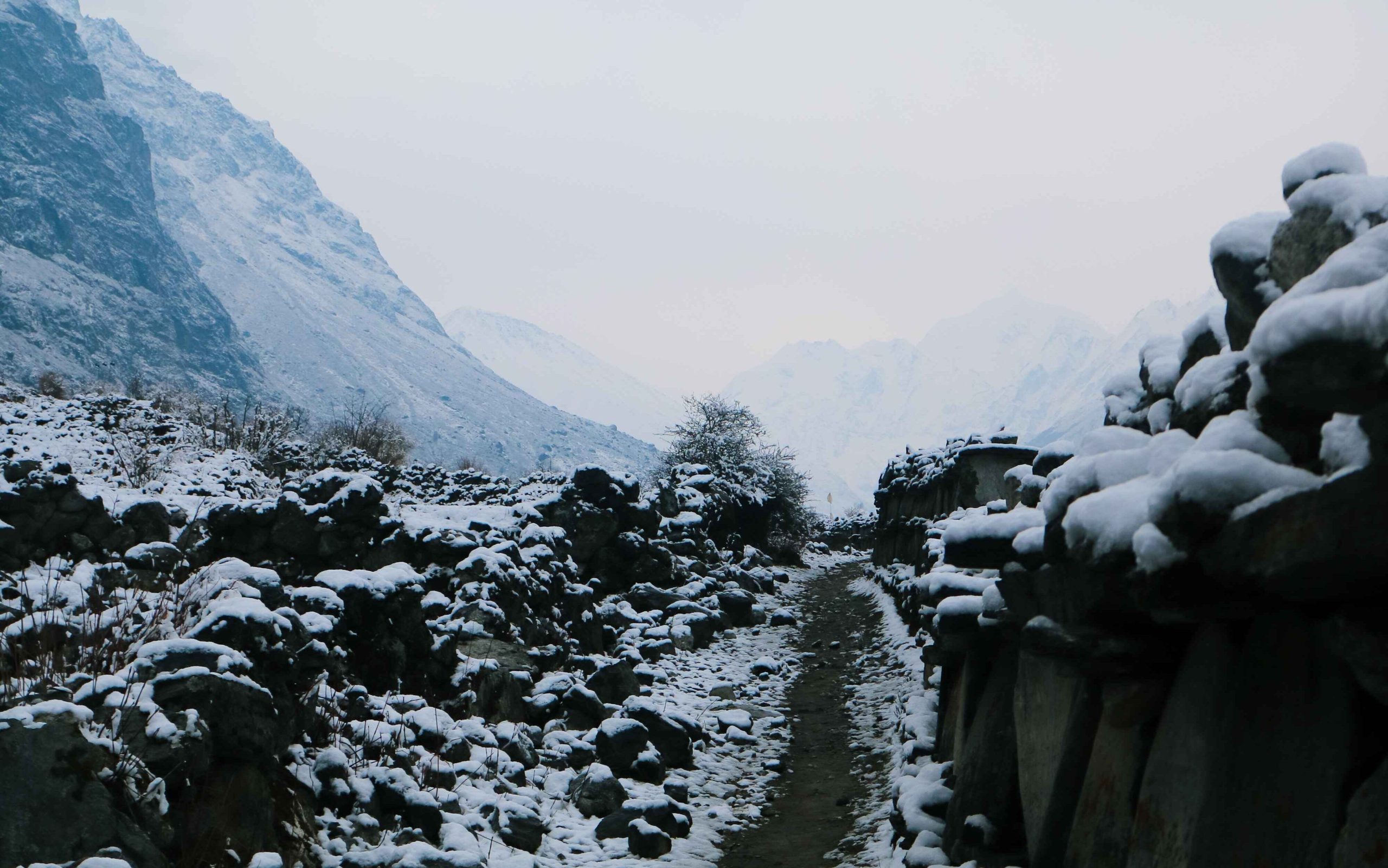

Halfway we passed a large boulder, with a café built against it, which was appropriately called: the Hard Rock Café. Unfortunately, they had no guitars on display, but they did have bounties and snickers, which by then was our favorite snack. There we chatted a bit with the friends we had made the previous day, and walked on, eager to get to our next destination early enough for lunch.
We came to Kyanjin Gompa around noon, and while we initially wanted to go up to Kyanjin Ri that day, my body and the clouds blocking our view made us postpone the climb to the next morning. So, the rest of the day we played cards, had food and chocolate, and we all took a nap. I also worked on my interview transcripts a bit, and once again we had dinner early, as we planned to wake up between four and five to get the best views from Kyanjin Ri.
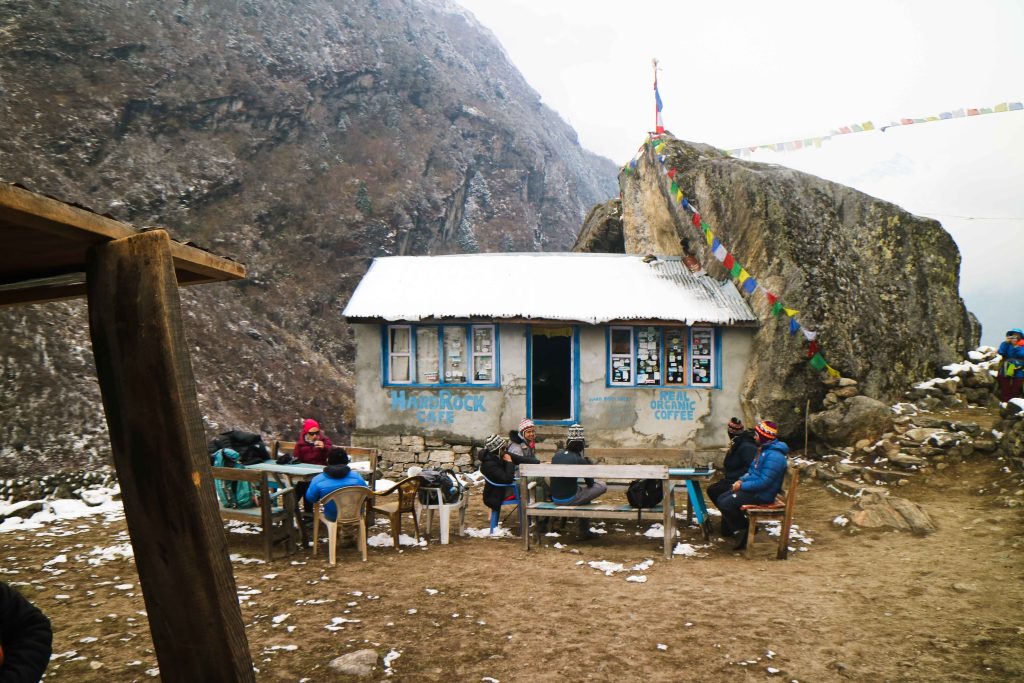

Day 4: Kyanjin Gompa (3830m) to Lower (4300m) to Higher Kyanjin Ri (4773m) to Langtang Village (3500m)
That morning, we went up the mountain immediately, without breakfast. Joshua carried the only backpack we would need that day, and we filled it with snacks and bottles of water. I also felt much better, as I had no heavy backpack and I finally was properly acclimatized. We basically ran up that mountain and got there as early as 7:30. While the climb itself was a zig-zagging path up the mountain, and therefore not very spectacular, the views were indescribable! If the views were already that great from halfway up, could you imagine what you would see when we reached our highest point of the day?
At Lower Kyanjin Ri it was already quite busy that early in the morning. We had our breakfast there and celebrated reaching this peak. Everyone was ecstatic because of the views, and perhaps the lack of oxygen. Words nor photos can do these mountains justice. When you are standing at the highest point you have ever been in your life, and you are still surrounded by mountains that are at least 3000 meters taller, you feel so tiny. I remember feeling in awe of nature and I had to pinch myself as my dream of climbing a mountain in the Himalayas had finally come true.
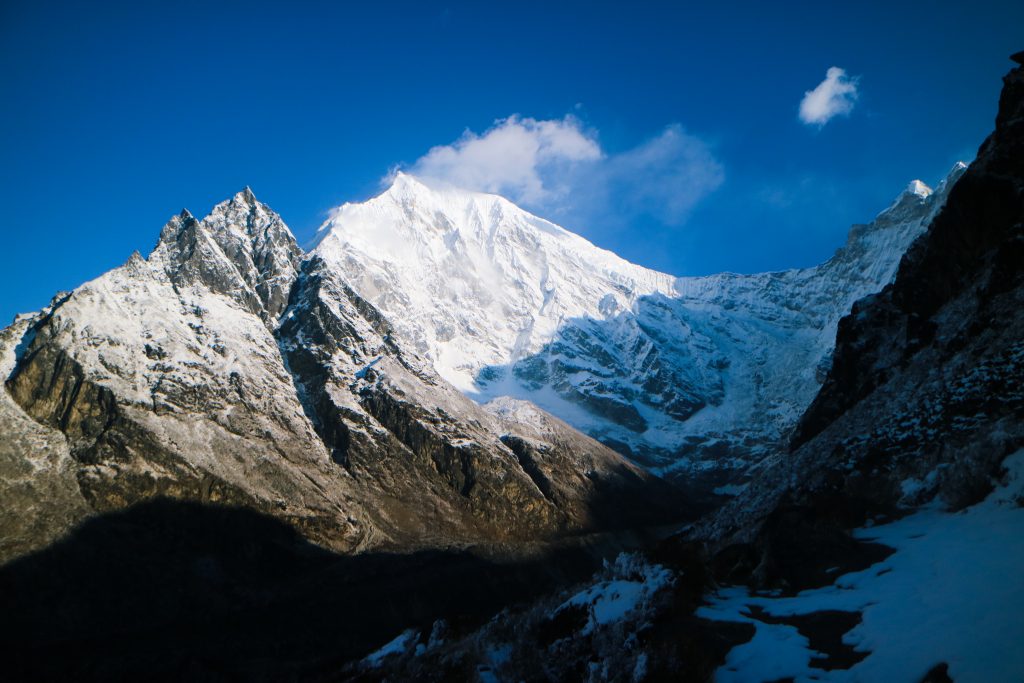
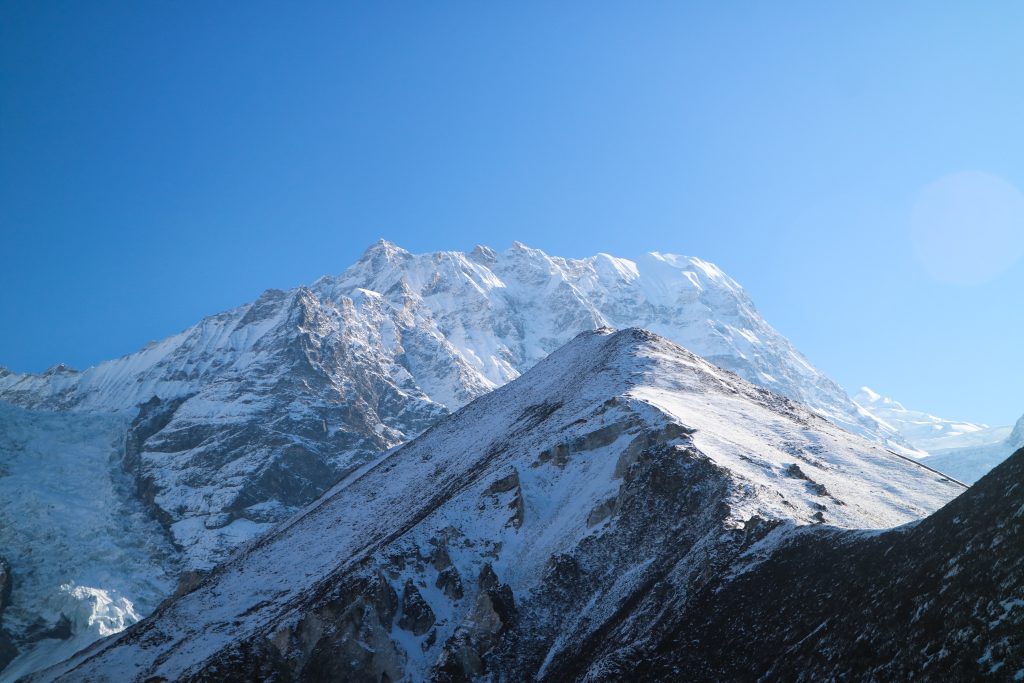
As we were feeling so good at the lower peak, we decided to go to Higher Kyanjin Ri as well, which would take us up to 4773 meters. This part went straight up the ridge of the mountain, and it was getting a little more slippery, as we had to walk through snow that was slowly melting in the sun. Looking down, I knew I would roll down a couple hundred meters if I would trip. For the thousandth time I thanked my walking sticks, which helped me keep my balance.
Suddenly we heard some thunder to our left, and we could see an avalanche coming down with tremendous speed between the mountains of Langtang Lirung and Kimshung. The force of nature that was displayed there in seconds left us all in awe. I shivered thinking about possible mountaineers on that mountain. Hopefully no one was climbing that day.
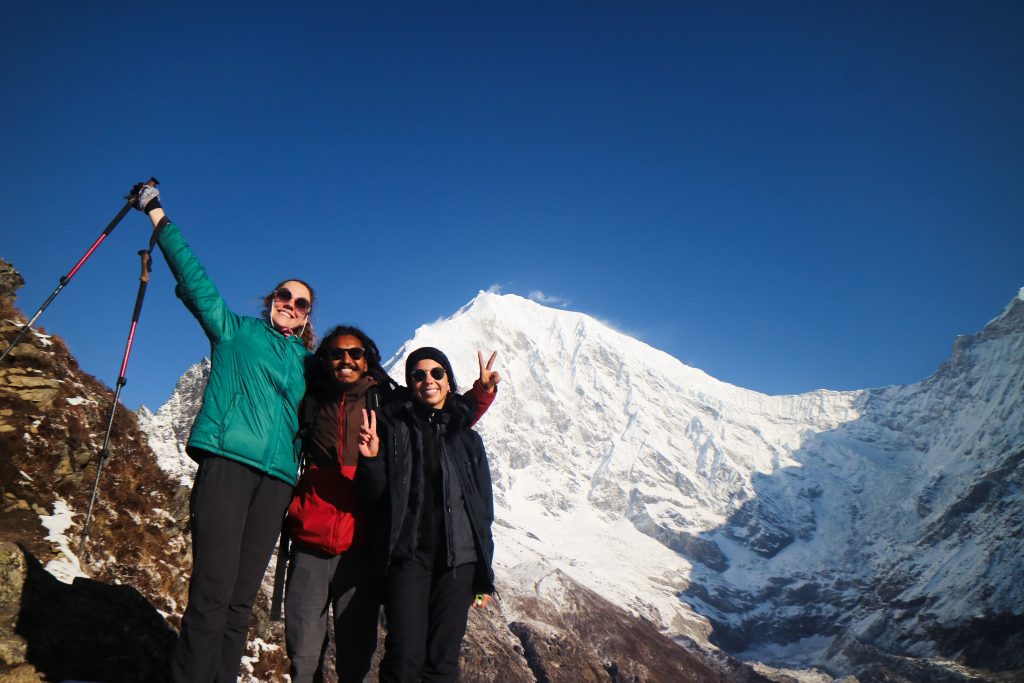
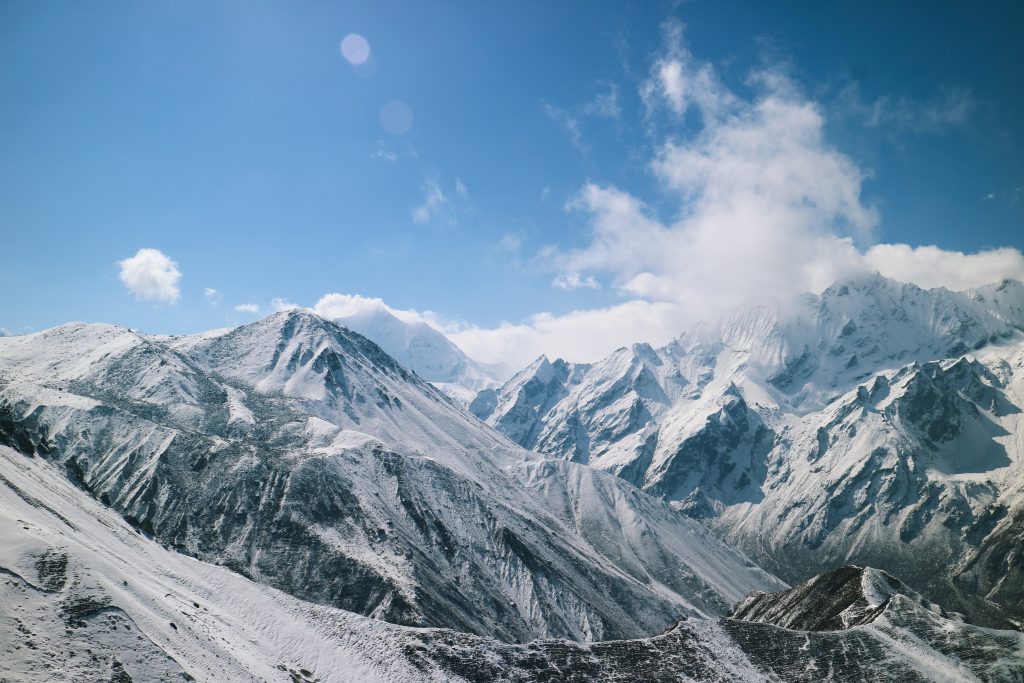
Eventually we reached higher Kyanjin Ri, and the views were even better from there. We took more pictures and videos, and ate some more snacks while taking it all in, knowing we had to come down soon. As we were feeling so good, we decided we would go back to the guest house for lunch, and then pack up to walk all the way back down to Langtang Village. We descended from Kyanjin Ri quickly, and were in Langtang in no time. There, we stayed at the same hotel, and once again enjoyed our evening, reflecting on everything we saw that day.
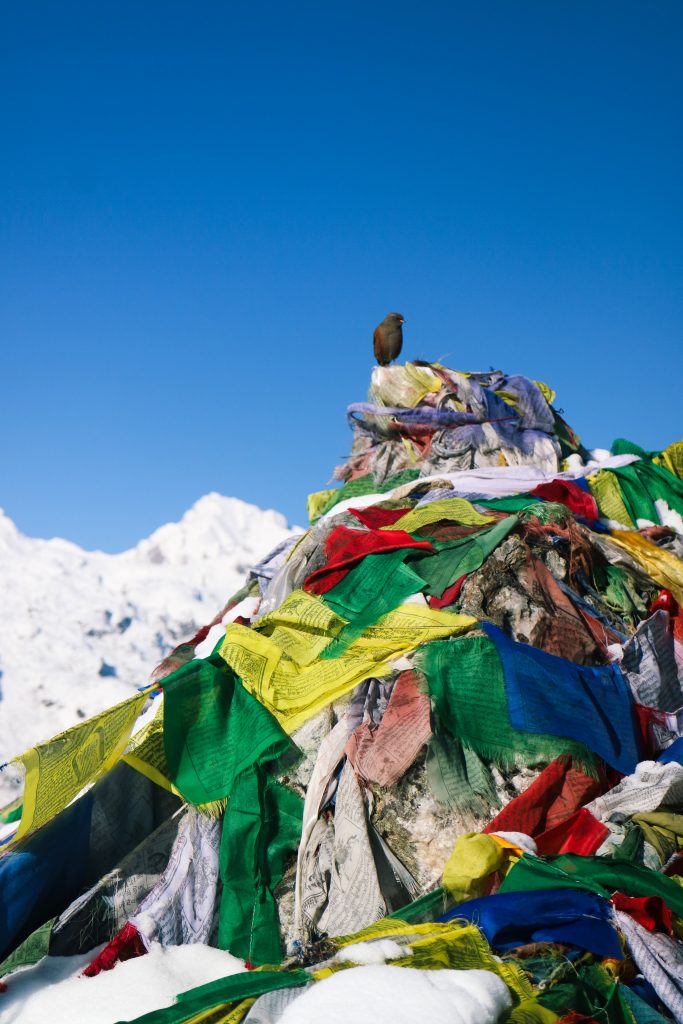
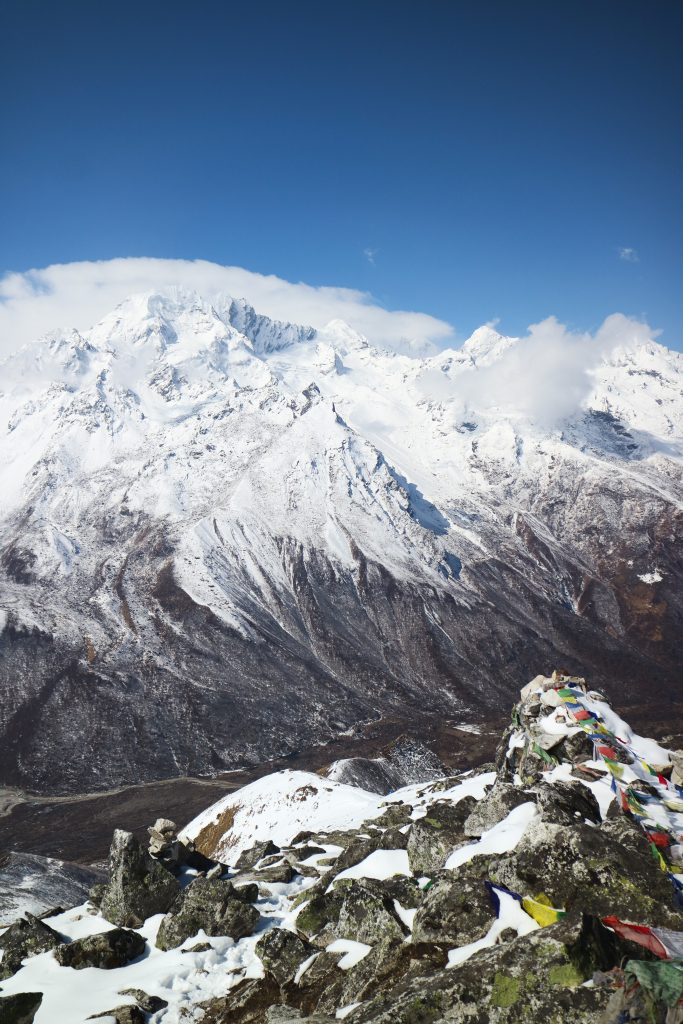
Day 5: All the way back to Syabru Besi
That day we decided to see how far we would get in one day, but Laurence and I were pretty determined to get back to Patan in time, as we had made a deal to get our nails done. We thought it would be the best contrast with our days in the mountains. We left early, again, and walked down fast. As we had to walk back the same way we came, we had already seen the views, and did not stop as often to take pictures.
Halfway we had some lunch, and took about forty-five minutes to rest. This was needed, as we planned on descending 2000 meters in one day, which I will definitely not recommend. By the end of the day I felt in over my head. The walking started to get monotonous as I was only looking at my feet, and my knees and feet hurt badly by the end of it. Taking more time for the views would not have been a bad idea, but my nails and feet were happy two days later during my first ever mani-pedi! We also got to stay in Joshua and his wife Amanda’s gorgeous Airbnb once we got back to Patan, which helped us get through the final kilometers.
When we got to the road near Syabru Besi, however, a jeep passed us and we decided to hitchhike for the final stretch. It kind of felt like we were cheating, but my knees thanked me, and after being spoiled with the views from the past few days, walking on a road was not that attractive anymore. Exhausted we got to the Sunrise Hotel around five PM, and had the luxury of a hot shower there. Content, we reflected on the past five days, which were full of physical highs and lows, but mostly left us with memories we could never forget. We saw the most beautiful landscapes and had so many nice conversations and laughter with the three of us, which made my painful knees and feet a bittersweet reminder of all the fun we had had the past days. Langtang, we will never forget you!
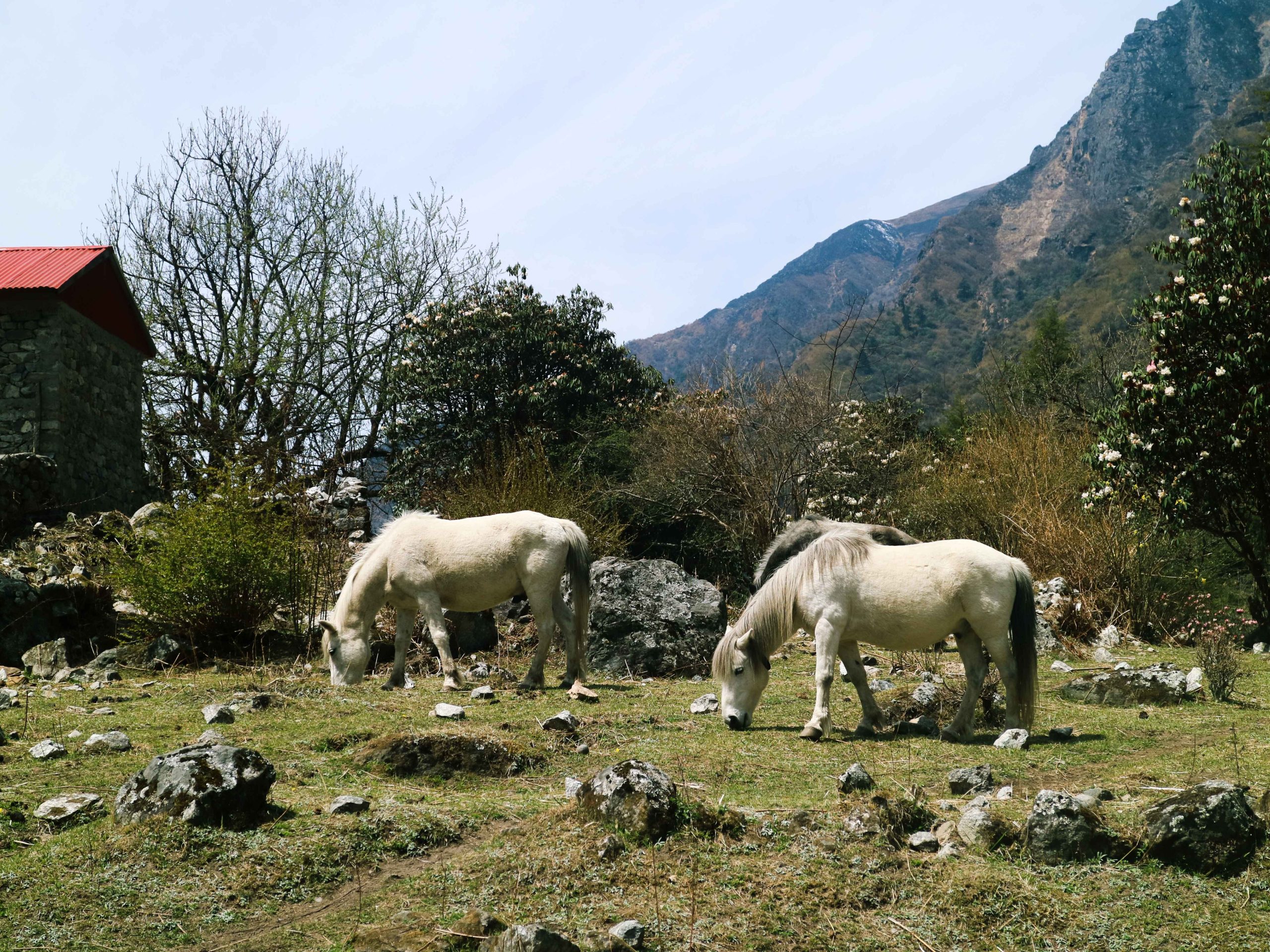
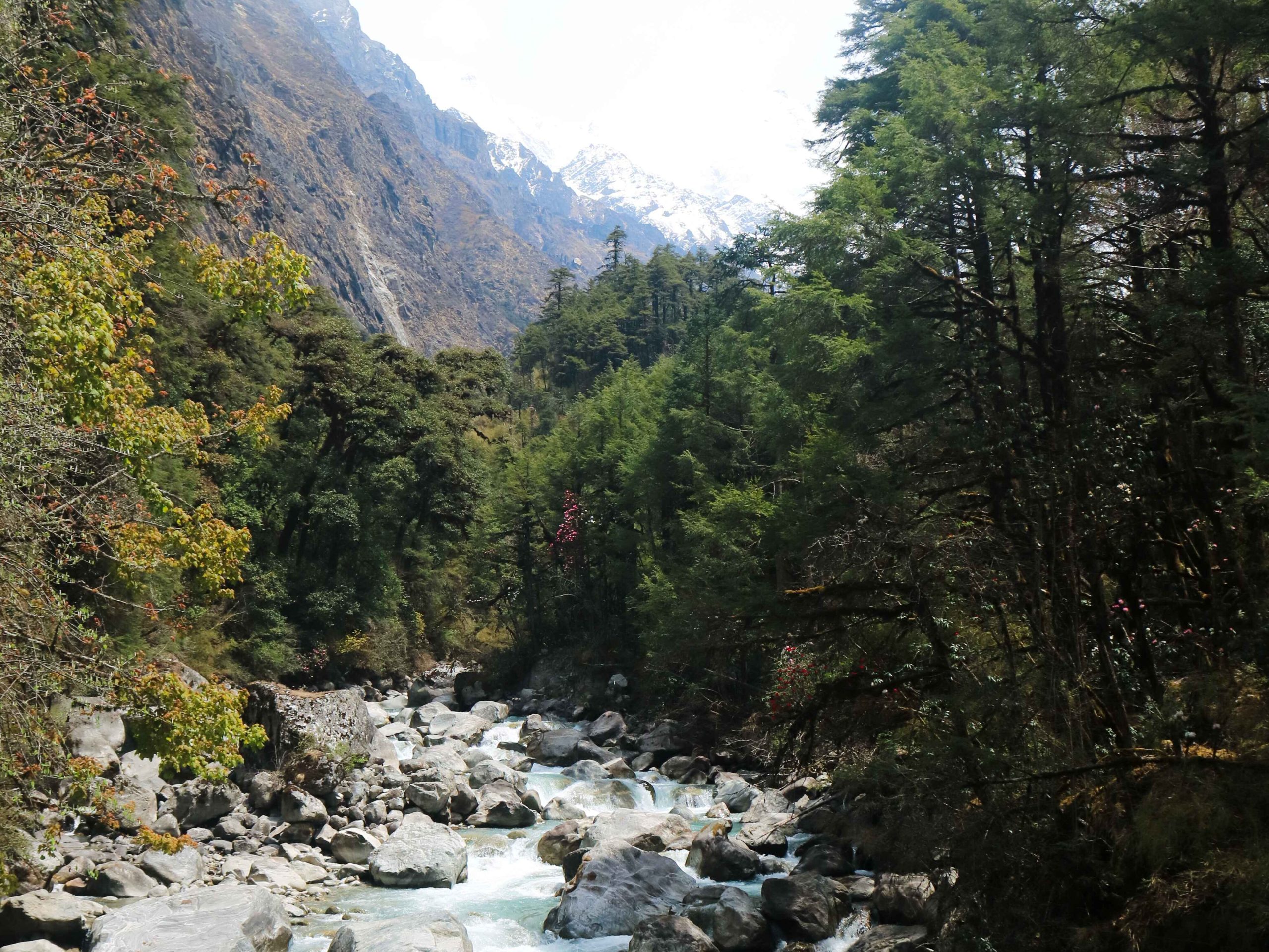
Final Thoughts
Hiking the Langtang Valley Trek with Laurence and Joshua was by far one of the best experiences of my life yet. I would not have wanted to do it any differently that time around, as it was perfect, even with small inconveniences like pain in my knees. The physical struggle made it even better!
However, if I would do it again or would give advice to future trekkers (which might be you if you came this far!), I would say: take. your. time. I personally like challenging myself as I am a very competitive person, but you can also take it too far. If I would have had the time, I would have taken it slower, and maybe even added a climb to Tsjerko Ri, a higher peak near Kyanjin Gompa, or hiked to the lake of Gosaikunda from Lama Hotel. There are many more experiences to be had and views to be seen in the Langtang range, so when you are there, make sure to live them. Still, my dream came true, and I could not have wished for a better experience!
If you go, make sure to send Joshua a message via his Instagram. He made everything fun and easy and was super knowledgeable and responsible concerning physical limitations. Even if he does not have the time, he has other friends who are just as invested as him in making your trek the best experience of your life. And if you go with him, make sure to say hi from me!
Gluten-Free on the Trek
Wondering what I ate and if it is even possible to eat gluten-free on the trek? My answer is short and simple: dal baht. However, with many types of fried rice, curries, and potatoes, you will get there. For breakfast they make buckwheat pancakes too if you ask the hosts, and their porridge is made of oatmeal usually. If you are celiac, make sure to contact your guide about this, as they can easily communicate your needs to the guest houses you will be staying at.




